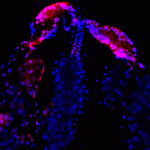Lien vers Pubmed [PMID] – 37656759
Lien DOI – 10.1371/journal.pntd.0011593
PLoS Negl Trop Dis 2023 Sep; 17(9): e0011593
Dengue virus (DENV) transmission from humans to mosquitoes is a poorly documented, but critical component of DENV epidemiology. Magnitude of viremia is the primary determinant of successful human-to-mosquito DENV transmission. People with the same level of viremia, however, can vary in their infectiousness to mosquitoes as a function of other factors that remain to be elucidated. Here, we report on a field-based study in the city of Iquitos, Peru, where we conducted direct mosquito feedings on people naturally infected with DENV and that experienced mild illness. We also enrolled people naturally infected with Zika virus (ZIKV) after the introduction of ZIKV in Iquitos during the study period. Of the 54 study participants involved in direct mosquito feedings, 43 were infected with DENV-2, two with DENV-3, and nine with ZIKV. Our analysis excluded participants whose viremia was detectable at enrollment but undetectable at the time of mosquito feeding, which was the case for all participants with DENV-3 and ZIKV infections. We analyzed the probability of onward transmission during 50 feeding events involving 27 participants infected with DENV-2 based on the presence of infectious virus in mosquito saliva 7-16 days post blood meal. Transmission probability was positively associated with the level of viremia and duration of extrinsic incubation in the mosquito. In addition, transmission probability was influenced by the day of illness in a non-monotonic fashion; i.e., transmission probability increased until 2 days after symptom onset and decreased thereafter. We conclude that mildly ill DENV-infected humans with similar levels of viremia during the first two days after symptom onset will be most infectious to mosquitoes on the second day of their illness. Quantifying variation within and between people in their contribution to DENV transmission is essential to better understand the biological determinants of human infectiousness, parametrize epidemiological models, and improve disease surveillance and prevention strategies.

